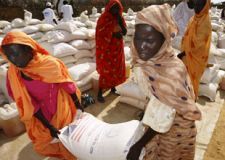Darfur conflict threatens aid operation
Dec 31, 2006 (KHARTOUM) — As Darfur’s conflict enters its fourth year and fighting engulfs main towns, the world’s largest humanitarian operation in Sudan’s remote west has become increasingly threatened.
 The clashes which drove some 2.5 million Darfuris from their homes and killed an estimated 200,000 were concentrated in remote villages in the early stages of the conflict. But the terror has spread to Darfur’s main towns, affecting many of the 14,000 aid workers based there.
The clashes which drove some 2.5 million Darfuris from their homes and killed an estimated 200,000 were concentrated in remote villages in the early stages of the conflict. But the terror has spread to Darfur’s main towns, affecting many of the 14,000 aid workers based there.
“These places were safe havens before,” said Alun MacDonald, spokesman for British aid agency Oxfam. “Our headquarters are in the town, so it does affect operations,” he said. “It’s frustrating.”
Many war victims fled to the relative safety of the three Darfur state capitals during the conflict and formed mass makeshift camps surrounding the towns.
But that feeling of safety was shattered when militia ran riot several times in recent months or clashed with former rebel forces inside Darfur’s main towns. In December U.N. and aid agencies evacuated hundreds of staff from Darfur cities, paralyzing some humanitarian operations.
“The situation here remains like a tinderbox,” said one aid worker who witnessed clashes in December in el-Fasher town before evacuated.
With a May peace deal signed by only one rebel faction, violence has escalated as many other rebel commanders formed a new military alliance and renewed hostilities with the government. U.N. officials say Khartoum remobilized proxy militia, known locally as Janjaweed, to combat the rebellion.
U.S. academic Eric Reeves says the militia are in the towns because the new rebel alliance had inflicted heavy losses in remote areas on government forces and their proxy militia.
“The towns now offer safe haven and easy pickings for the Janjaweed, and they are certainly less fully under control of the Sudanese armed forces,” he said.
The Janjaweed “report to no one,” the aid worker in el-Fasher said, adding “there is a huge amount of tension between the Janjaweed, the government of Sudan and the police.”
In West Darfur’s capital el-Geneina, armed men dressed in various military fatigues roam the streets in unmarked vehicles. As well as militia, insurgents from neighboring Chad drive in and out of the town.
Aid compounds in many of Darfur’s major towns have been targeted by armed men in the past few months. In North Darfur’s Tawila town, all the international aid agencies have left, leaving tens of thousands of victims without help.
Oxfam’s MacDonald said with the May deal, there were many more armed factions in the towns as former rebel forces have gained legitimacy but have not yet laid down their weapons. “There are lots more men with guns inside the towns,” he said.
Most agencies are reluctant to leave Darfur, which U.N. officials call the world’s worst humanitarian crisis, but many are operating dangerously close to the edge, stretching normal operational rules.
“They are all operating in the red zone, beyond acceptable levels of security,” said Reeves. “They would never think of entering a situation like Darfur if they weren’t already there.”
Mia Farrow, the goodwill ambassador for the U.N. Children’s Agency (UNICEF), warned hundreds of thousands were already out of reach of the aid operation because of the growing violence and the situation was likely to get worse especially if evacuations of aid workers continued.
“The people of Darfur are utterly helpless to protect themselves and their children from the tsunami of violence that is about to engulf them,” she said.
(Reuters)
